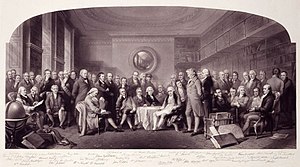

William Walker (1 August 1791 – 7 September 1867) was a Scottish engraver. He is known for engravings of Sir Henry Raeburn's portraits of Sir Walter Scott and Raeburn himself, Sir Thomas Lawrence's portrait of Lord Broughham (commissioned by Walker), and Alexander Nasmyth's portrait of Robert Burns.[3]
- ^ Engraving after 'Men of Science Living in 1807-8', John Gilbert engraved by George Zobel and William Walker, ref. NPG 1075a, National Portrait Gallery, London, accessed February 2010
- ^ Smith, HM (May 1941). "Eminent men of science living in 1807-8". J. Chem. Educ. 18 (5): 203. doi:10.1021/ed018p203.
- ^ . Dictionary of National Biography. London: Smith, Elder & Co. 1885–1900.